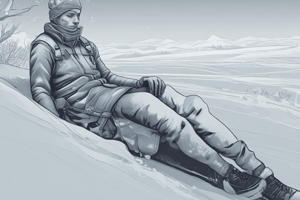Podcast
Questions and Answers
What is the primary cause of cold stress?
What is the primary cause of cold stress?
- Exposure to high temperatures
- Inadequate heat production by the body (correct)
- High humidity levels
- Excessive physical activity
Which of the following is NOT a typical symptom of hypothermia?
Which of the following is NOT a typical symptom of hypothermia?
- Drowsiness
- Shivering
- Warm skin (correct)
- Slurred speech
What immediate action should be taken for someone with severe frostbite?
What immediate action should be taken for someone with severe frostbite?
- Rub the affected area to promote circulation
- Offer warm beverages to warm the body
- Immerse the affected area in hot water
- Cover the area and seek medical attention (correct)
What is trench foot primarily caused by?
What is trench foot primarily caused by?
Which of the following layers is NOT recommended for cold weather clothing?
Which of the following layers is NOT recommended for cold weather clothing?
What is a recommended safety measure for driving in cold weather conditions?
What is a recommended safety measure for driving in cold weather conditions?
Which type of heater is effective for managing cold exposure?
Which type of heater is effective for managing cold exposure?
What factor does NOT contribute to an increased risk of cold stress?
What factor does NOT contribute to an increased risk of cold stress?
Flashcards are hidden until you start studying
Study Notes
Cold Stress Overview
- Cold stress occurs when the body loses heat faster than it can be produced, often in temperatures below 32°F.
- Factors contributing to cold stress are environmental (cold temperatures, wind, precipitation) and personal (inadequate clothing, pre-existing health conditions).
Hypothermia
- Defined by a dangerous drop in body temperature, below 95°F indicating severe health risks including organ shutdown.
- Initial symptoms include shivering, slurred speech, shallow breathing, and drowsiness.
- As body temperature continues to decline, symptoms escalate to confusion, inability to move, and loss of consciousness.
- Recommended actions for severe hypothermia include calling 911 and moving the affected individual to a warm area.
Frostbite
- Frostbite is caused by freezing skin and tissue, typically affecting extremities like fingers, toes, and face.
- Symptoms start as reddening of skin and numbness, progressing to discoloration (pale/white) and warmth, indicating more severe injury.
- Deep frostbite results in bluish-gray skin with complete loss of sensation and potential for blistering and tissue death.
- Do not rub the frostbitten area; instead, cover it and seek medical attention.
Trench Foot
- Occurs from prolonged exposure to cold and wet conditions, even at temperatures as high as 60°F.
- Feet lose heat rapidly when wet, leading to symptoms like redness, numbness, swelling, and blisters.
- If untreated, can lead to gangrene and the need for amputation.
- Immediate actions include removing shoes, drying feet, and replacing wet socks.
Cold Weather Clothing
- Dressing in layers is crucial: a base layer (polyester, wool, silk) to wick moisture, an insulating layer (wool, down), and an outer shell (water-resistant fabric).
- Additional protective gear includes winter hats, gloves, boots, long underwear, and face masks for extreme cold.
Engineering Controls
- Use of radiant heaters, propane heaters, and insulated spaces can help manage cold exposure.
- Acclimatization to cold weather requires gradually increasing workload and taking breaks.
Winter Hydration
- Importance of staying hydrated with warm, sweetened liquids while avoiding alcohol to prevent dehydration.
Transportation Risks
- Cold weather increases risks of transportation-related injuries, primarily from slippery conditions leading to accidents.
- Safe driving policy recommends a following distance of 5-7 seconds to accommodate for slower stopping times.
Safe Driving Techniques
- Understanding vehicle features like ABS (Anti-lock Braking System) can improve control during winter conditions.
- If equipped with ABS, maintain steady brake pressure; if not, pump brakes to avoid skidding.
- Decelerate before turns and apply gentle pressure while navigating.
- In case of skidding, steer in the direction of the skid without braking.
Conclusion
- Winter conditions require vigilance in health, clothing, and driving practices to prevent cold-related injuries and transportation accidents.
Cold Stress Overview
- Cold stress occurs when heat loss exceeds heat production, particularly in sub-32°F temperatures.
- Factors include environmental elements (cold, wind, precipitation) and personal conditions (inadequate clothing, pre-existing health issues).
Hypothermia
- Hypothermia is characterized by body temperature falling below 95°F, posing severe health risks.
- Initial symptoms include shivering, slurred speech, shallow breathing, and drowsiness.
- As temperature drops, symptoms worsen to confusion, immobility, and loss of consciousness.
- In severe cases, immediate action includes calling emergency services and relocating the individual to a warmer environment.
Frostbite
- Frostbite occurs when skin and tissue freeze, primarily affecting extremities (fingers, toes, face).
- Early symptoms are skin reddening and numbness, progressing to pale or white discoloration indicating severe damage.
- Deep frostbite presents with bluish-gray skin, complete loss of sensation, risk of blistering, and tissue death.
- Rubbing frostbitten areas is harmful; cover them and seek medical help.
Trench Foot
- Trench foot results from prolonged cold and wet exposure, even at temperatures as mild as 60°F.
- Symptoms include redness, numbness, swelling, and blisters due to rapid heat loss in wet conditions.
- Untreated trench foot can lead to gangrene and potential amputation.
- Immediate treatment involves removing shoes, drying feet, and changing wet socks.
Cold Weather Clothing
- Layering is essential: a moisture-wicking base layer (polyester, wool, silk), an insulating layer (wool, down), and a protective outer shell (water-resistant fabrics).
- Essential gear includes winter hats, gloves, boots, long underwear, and face masks for extreme cold situations.
Engineering Controls
- Utilize radiant heaters, propane heaters, and insulated spaces to reduce cold exposure risks.
- Acclimatization is important; gradually increase workload while taking frequent breaks.
Winter Hydration
- Staying hydrated is crucial; warm, sweetened drinks are preferable over alcohol, which can lead to increased dehydration.
Transportation Risks
- Cold weather raises transportation-related injury risks due to slippery surfaces.
- Recommended safe following distance while driving in winter is 5-7 seconds to account for longer stopping distances.
Safe Driving Techniques
- Familiarity with vehicle features like ABS (Anti-lock Braking System) enhances control in winter conditions.
- For ABS-equipped vehicles, maintain steady brake pressure; otherwise, pump brakes to avoid skidding.
- Slow down before turns and apply gentle pressure during navigation to maintain control.
- If skidding occurs, steer in the skid direction without pressing the brakes to regain control.
Conclusion
- Vigilance in health management, appropriate clothing, and safe driving practices is essential to prevent cold-related health issues and transportation accidents.
Studying That Suits You
Use AI to generate personalized quizzes and flashcards to suit your learning preferences.




